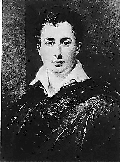

 George Gordon Byron was the son of Captain John Byron and Catherine Gordon. He was born in London in 1788.
George Gordon Byron was the son of Captain John Byron and Catherine Gordon. He was born in London in 1788.
In 1798 George got his title, Baron Byron of Rochdale, after the death of his great-uncle. Money from his dead uncle provided Lord Byron with an education at Trinty College, Cambridge.
In 1807 Lord Byron's first collection of poems, Hours of Idleness. Lord Byron was soon in a scandal by starting an affair with Lady Caroline and was renounced when rumours of having sexual intercourse with his half-sister, Augusta Leigh.
In 1809 Byron escaped to Spain, Malta, Albania and Greece. His account of this grand tour ammounted to "Childe Harold's Pilgrimage" (1812). The poem established Byron as one of England's leading poets.
Byron attended the House of Lords. Which he became an advocate of social reform. In 1811 he was one of the few men in Parliament to defend the actions of the Luddites and spoke out against the Frame Breaking Bill. Byron's views influenced the content of his poems. Song for the Luddites (1816) and The Landlords' Interest (1823). Byron also attacked his political opponents such as the Duke of Wellington and Lord Castlereagh in Wellington: The Best of the Cut-Throats (1819) and the The Intellectual Eunuch Castlereagh (1818).
In 1815 Byron married Anne Isabella Milbanke but the relationship came to an end the following year. Byron moved to Venice where he met the Countess Teresa Guiccioli, who became his mistress. Some of Byron's best known work belongs to this period including Don Juan. Lord Byron also began contributing to the radical journal, the Examiner, edited by his friend, Leigh Hunt. Leigh Hunt, like other radical journalists had suffered as as result of the Gagging Acts and had been imprisoned for his attacks on the monarchy and the government.
In 1822 Byron, Leigh Hunt, and Percy Bysshe Shelley travelled to Italy where the three men published the political journal, The Liberal. It was rumor that Byron was having an affair with Percy Shelly's wife, Mary Shelly, the famed author of "Franstein" and Percy himself. The four friends were always seen together. The liberal was written by all four friends and was soon in print. The first edition was mainly written by Leigh Hunt but also included work by William Hazlitt, Mary Shelley and Byron's Vision of Judgement sold 4,000 copies. Three more editions were published but after the death of Shelley in August, 1822, the Liberal came to an end. Soon after in April, 1824, Lord Byron died of marsh fever in Missolonghi.